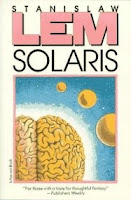Stanislaw Lem's "Solaris" (novel, first contact): Communicating with aliens can be REALLY hard, if at all possible
 My first impression was a bit of let down - because I'd been led to believe it's "linguistic sf" (via an article in, I think, Routledge(?) Companion to Science Fiction - could have been my misunderstanding). It's nothing of the sort. While communications with an alien is a central theme, it's not about language as we normally understand it.
My first impression was a bit of let down - because I'd been led to believe it's "linguistic sf" (via an article in, I think, Routledge(?) Companion to Science Fiction - could have been my misunderstanding). It's nothing of the sort. While communications with an alien is a central theme, it's not about language as we normally understand it.
But once I got out of initial bias, it was generally a good read. But there are many tedious paragraphs & descriptions. At least some of the tediousness could be because of double translation - original Polish to French to English - something must have been lost in these translations.
Story summary.
Solaris is a water world somewhere out there, in a binary star system. Physics suggests its orbit should be unstable; reality is otherwise. This leads to suggestion of intelligent orbit correction.Solarian exploration has been going on for some 200 odd years, & it's ocean is now definitely known to be sentient. No progress has been made at contact though, in spite of minor incidents.
This story mostly happens at the (human research) Station, floating a bit above the Solarian ocean via some anti-gravity device; the station is capable of horizontal flight too.
Frustrated with inability to communicate with the ocean, the crew recently did high-energy X-ray bombardment of some parts of ocean. And it looks like the ocean has now noticed the puny humans.
Ocean is reacting in ways humans find creepy & impossible to comprehend. Ocean reads their
deepest repressed thoughts during their sleep, & has created actual in-flesh people in
those dreams & presented them to members! Crew members know these are ocean's creations, but find it impossible to rid them.
That's where we find the only really interesting human story: beginning of a real love affair between Dr Kris Kelvin (narrator) & his replica of his long dead wife Rheya. Both realize Rheya is unreal, but cannot help. Affair will have a tragic end - death of Rheya.
By the end, there is definitely a communication between humans & ocean - but what it means is anybody's guess! A parting conjecture of human party that stayed with me: can we look at the ocean as an "imperfect" baby god, still only learning its tricks; that's why it's been distracted & inconsistent during interactions with humans! What will it look like when it grows up? Humans "will have been the baby's toys for a while."
Notes.
- I didn't quite catch the details of the orbit of Solaris about its two stars. At one place, its orbiting them both (!); elsewhere it's between them. But through the story, we see one sun or the other rising. I guess it's rotating about one sun, & other is just destabilizing the orbit (which planet seems to counteract).
See also.
- Arthur Clarke's "Crusade": A world got sentient in dark interstellar depths & it's unusual reactions to presence of certain kind of beings in galaxy.
- Murray Leinster's "The Lonely Planet": Sentient planet wants humans for company because it's lonely!
- Alastair Reynolds' "Turquoise Days": Much of the colorful background in this story appears to be borrowed from Solaris.
Fact sheet.
First published: 1961 (in Polish). English translation by Joanna Kilmartin & Steve Cox in 1970 via the French translation.Rating: B.
Movie adaptations: Andrei Tarkovsky's "Solyaris" (1972) (in Russian); Steven Soderbergh's "Solaris" (2002) (in English).
TV film adaptation: (in Russian) Boris Nirenburg's "Solaris" (1968).
Related: First contact stories.

3 comments:
I've just been writing a paper comparing Lem with Solderbergh's 2002 film and Tarkovsky's 1972 Soviet Russian film. Firstly, Lem probably has no intention of getting the orbits of the double star and planet correct or consistant- I'm sure its strictly metaphorical. Secondly, he is critiquing how Science is done. Shaped by the contradictory and sometimes counterproductive motivations of the scientists. Compare "Solaristics" to real world Psychology. Or even more "hard-science" Neurobiology. Lem was serious about sci-fi actually being about Science. For that alone he needs to be reckoned with.
PS Tarkovsky is not very accessible, and Solderbergh turns the story into a Hollywood Romance. (predictably for the worse) But both with an important twist: Exploring Solaris and its visitors is made into a metaphor for film viewing and film making. See also Blade Runner again with this in mind- replicants Pris and Roy stand for film- (imperfect representations of "real" human life)
Anonymous:
"Lem probably has no intention of getting the orbits of the double star and planet correct or consistant- I'm sure its strictly metaphorical.": While I don't expect details of a Hal Clement, I do expect statements that make sense. It's not metaphorical, because orbit stabilization is the basis for humans to conclude there is something intelligent there. I'm just wondering if original Polish did make sense, & may be something was lost in double translation.
"he is critiquing how Science is done": Again, I'll beg to differ. He simply seems to be talking about some sort of fundamental incomprehensibility of the nature of the alien from human perspective, somewhat like Terry Carr's "Dance of Changer & the Three". On science part: I find more magic here than science.
Post a Comment